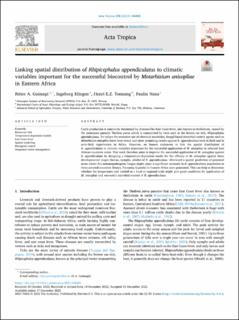| dc.contributor.author | Guimapi, Ritter A. | |
| dc.contributor.author | Klingen, Ingeborg | |
| dc.contributor.author | Tonnang, Henri E. Z. | |
| dc.contributor.author | Nana, Paulin | |
| dc.date.accessioned | 2023-03-20T12:44:37Z | |
| dc.date.available | 2023-03-20T12:44:37Z | |
| dc.date.created | 2023-01-02T16:02:15Z | |
| dc.date.issued | 2022-12-22 | |
| dc.identifier.citation | Acta Tropica. 2022, 238 . | en_US |
| dc.identifier.issn | 0001-706X | |
| dc.identifier.uri | https://hdl.handle.net/11250/3059268 | |
| dc.description.abstract | Cattle production is constantly threatened by diseases like East Coast fever, also known as theileriosis, caused by the protozoan parasite Theileria parva which is transmitted by ticks such as the brown ear tick, Rhipicephalus appendiculatus. To reduce the extensive use of chemical acaricides, fungal-based microbial control agents such as Metarhizium anisopliae have been tested and show promising results against R. appendiculatus both in field and in semi-field experiments in Africa. However, no known endeavors to link the spatial distribution of R. appendiculatus to climatic variables important for the successful application of M. anisopliae in selected East African countries exists. This work therefore aims to improve the successful application of M. anisopliae against R. appendiculatus by designing a temperature-dependent model for the efficacy of M. anisopliae against three developmental stages (larvae, nymphs, adults) of R. appendiculatus. Afterward a spatial prediction of potential areas where this entomopathogenic fungus might cause a significant epizootic in R. appendiculatus population in three selected countries (Kenya, Tanzania, Uganda) in Eastern Africa were generated. This can help to determine whether the temperature and rainfall at a local or regional scale might give good conditions for application of M. anisopliae and successful microbial control of R. appendiculatus. | en_US |
| dc.language.iso | eng | en_US |
| dc.publisher | Elsevier B.V. | en_US |
| dc.rights | Navngivelse 4.0 Internasjonal | * |
| dc.rights.uri | http://creativecommons.org/licenses/by/4.0/deed.no | * |
| dc.title | Linking spatial distribution of Rhipicephalus appendiculatus to climatic variables important for the successful biocontrol by Metarhizium anisopliae in Eastern Africa | en_US |
| dc.title.alternative | Linking spatial distribution of Rhipicephalus appendiculatus to climatic variables important for the successful biocontrol by Metarhizium anisopliae in Eastern Africa | en_US |
| dc.type | Peer reviewed | en_US |
| dc.type | Journal article | en_US |
| dc.description.version | publishedVersion | en_US |
| dc.rights.holder | © 2022 The Author(s) | en_US |
| dc.source.pagenumber | 9 | en_US |
| dc.source.volume | 238 | en_US |
| dc.source.journal | Acta Tropica | en_US |
| dc.identifier.doi | 10.1016/j.actatropica.2022.106800 | |
| dc.identifier.cristin | 2099042 | |
| dc.source.articlenumber | 106800 | en_US |
| cristin.ispublished | true | |
| cristin.fulltext | original | |
| cristin.qualitycode | 1 | |

